Abstract
Key pressing by squirrel monkeys was maintained under second-order schedules of either intramuscular cocaine injection or food presentation. Under one schedule, each completion of a 10-response fixed-ratio unit produced a brief visual stimulus; the first fixed-ratio unit completed after 30 minutes elapsed produced the stimulus paired with either cocaine injection or food presentation. Generally, short pauses followed by high rates of responding were maintained within the fixed-ratio units, and responding was positively accelerated over the 30-minute interval. Under another schedule, each completion of a 3-minute fixed-interval unit produced the brief stimulus; completion of the 10th fixed-interval unit produced the stimulus paired with either cocaine injection or food presentation. Generally, short pauses followed by high rates of responding were maintained within the fixed-ratio units, and responding was positively accelerated over the 30-minute interval. Under another schedule, each completion of a 3-minute fixed-interval unit produced the brief stimulus; completion of the 10th fixed-interval unit produced the stimulus paired with either cocaine injection or food presentation. Rates of responding increased within the fixed-interval units, and to a greater extent over the entire 10 fixed-interval units. Patterns of responding depended more on the schedule of reinforcement than on whether cocaine or food maintained responding. Omitting the brief stimuli following all but the last fixed-ratio or fixed-interval units decreased average rates and altered the patterns of responding. Substituting a visual stimulus that was never paired with cocaine or food following all but the last fixed-ratio or fixed-interval units decreased response rates to a lesser extent and did not substantially alter patterns of responding. When the duration of the paired stimulus was varied from .3 to 30.0 seconds, the highest response rates occurred at intermediate durations (1.0 to 10.0 seconds). The manner in which the stimulus changes affected performances depended more on the schedule of reinforcement than on whether cocaine injection or food presentation maintained responding.
Full text
PDF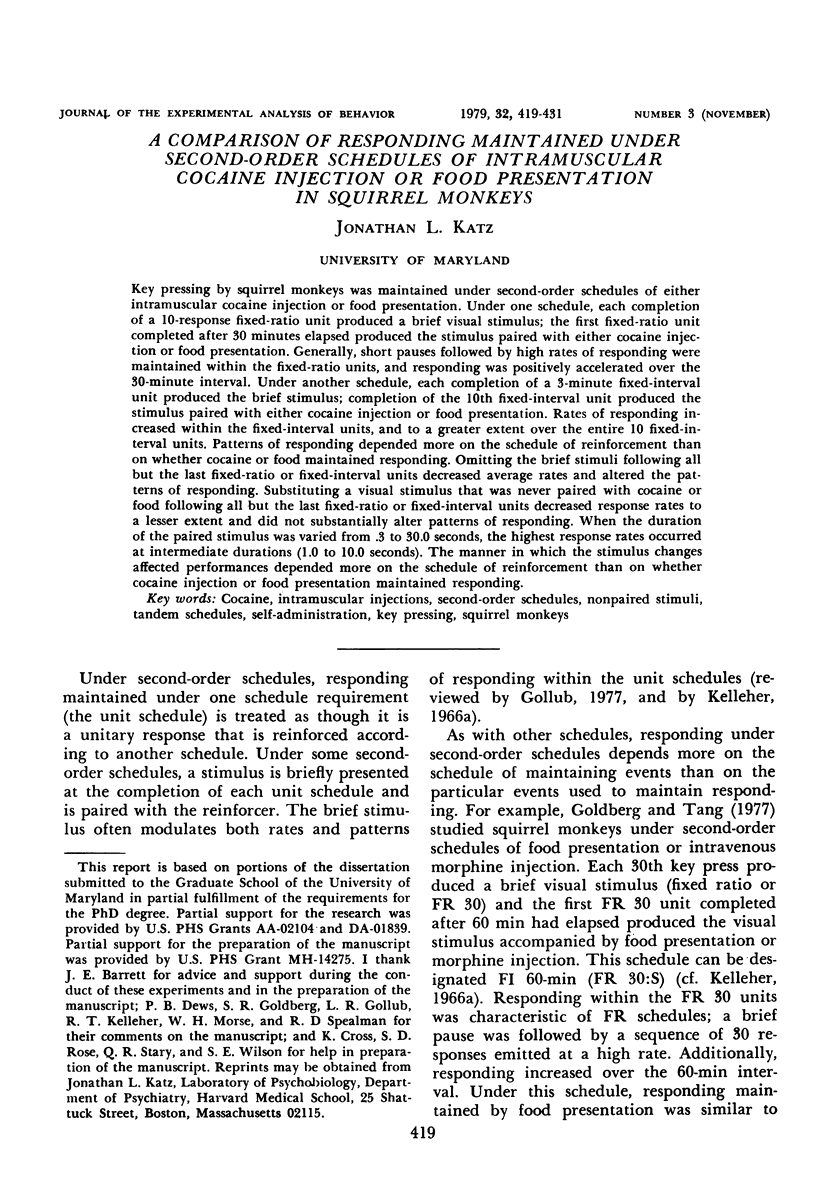
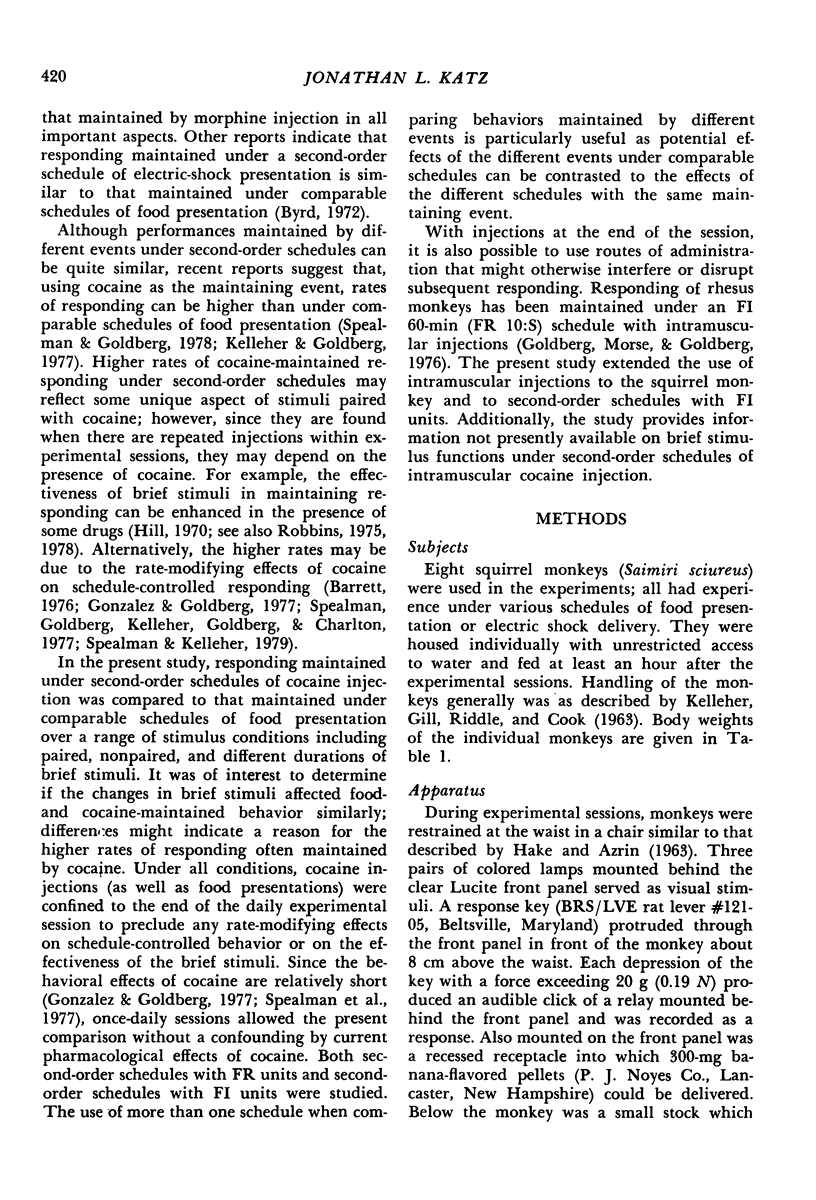

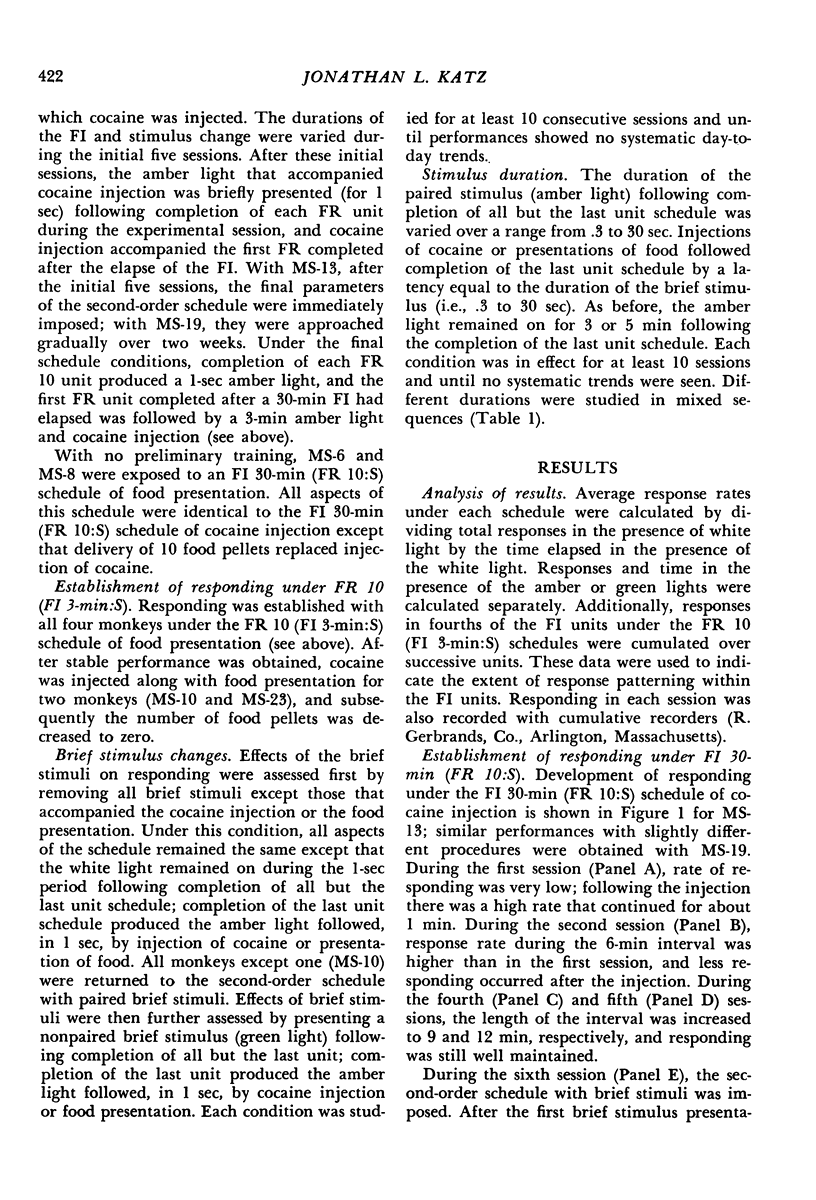

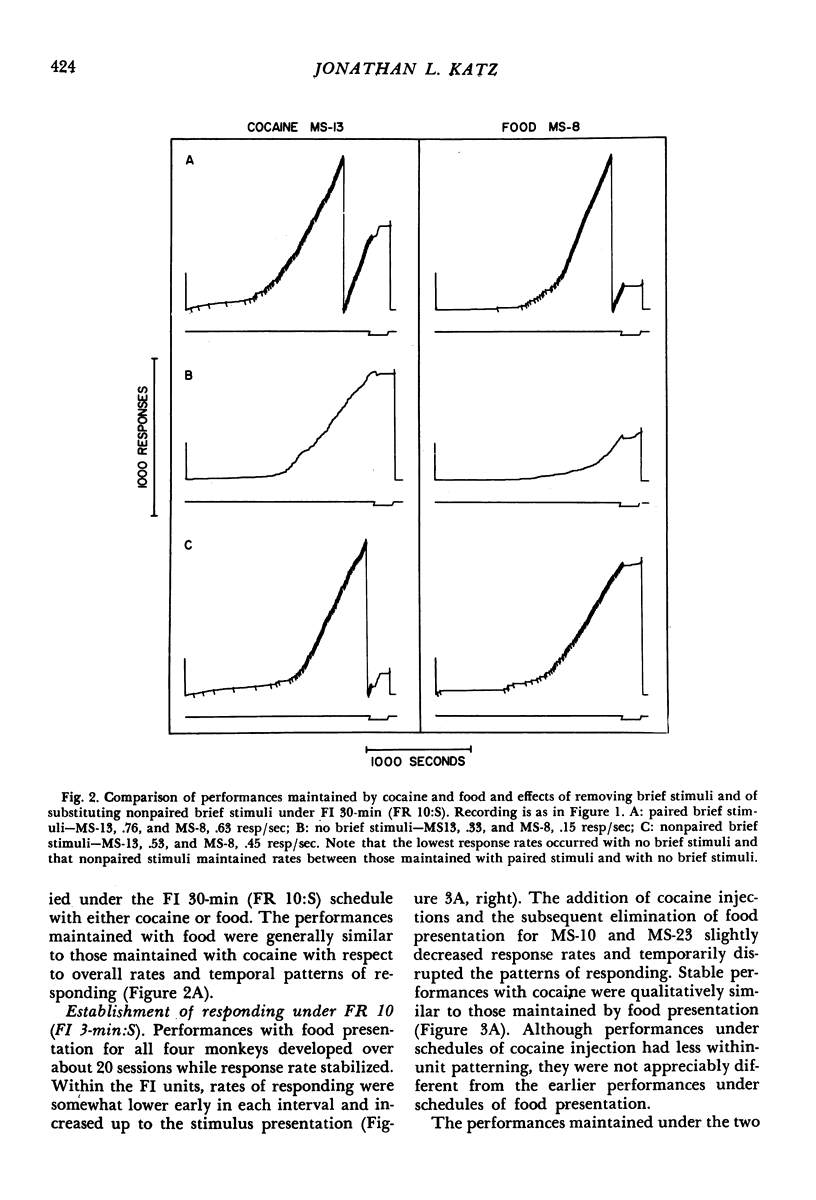
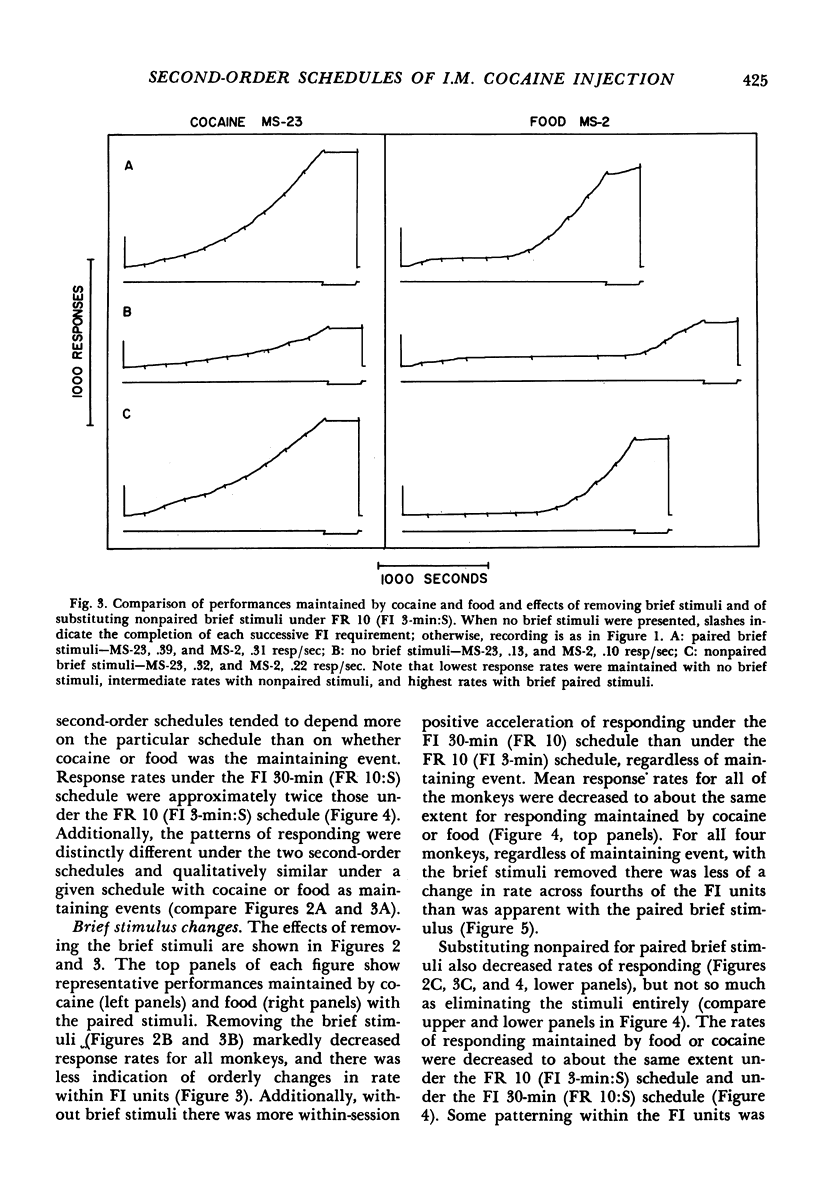


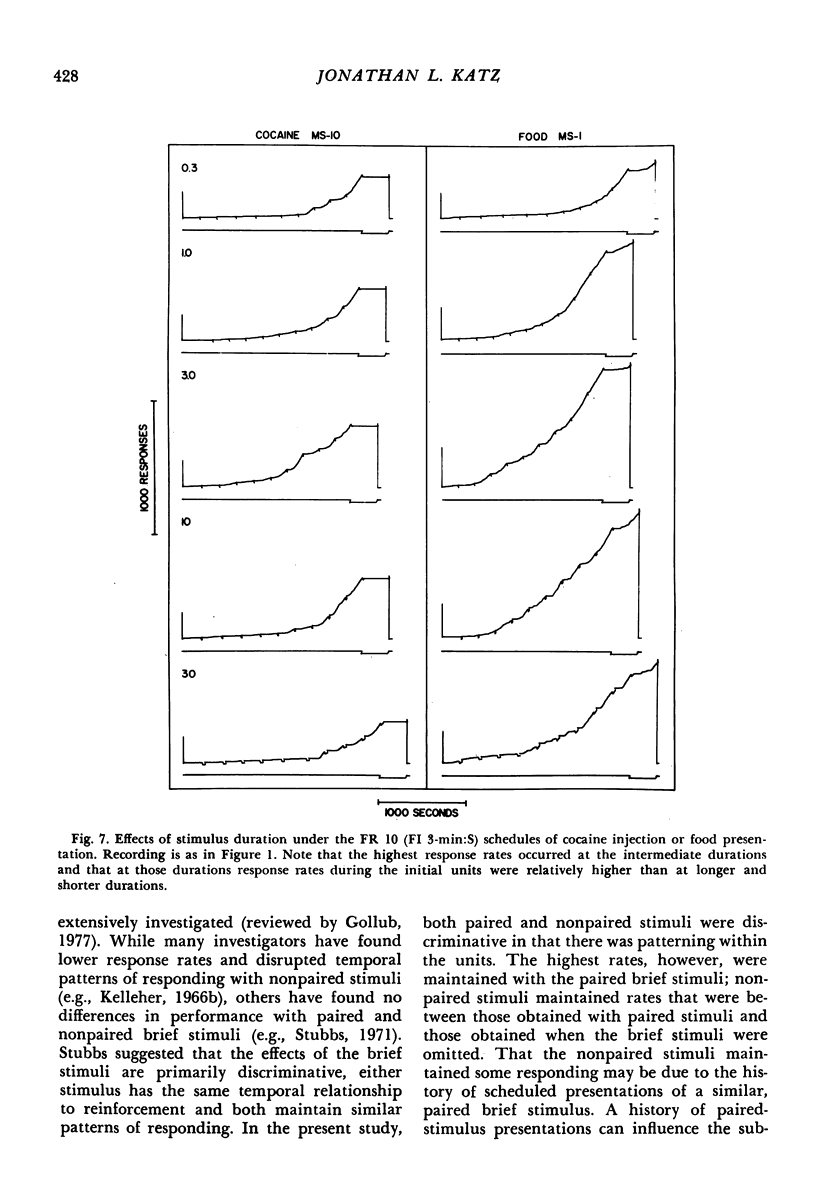
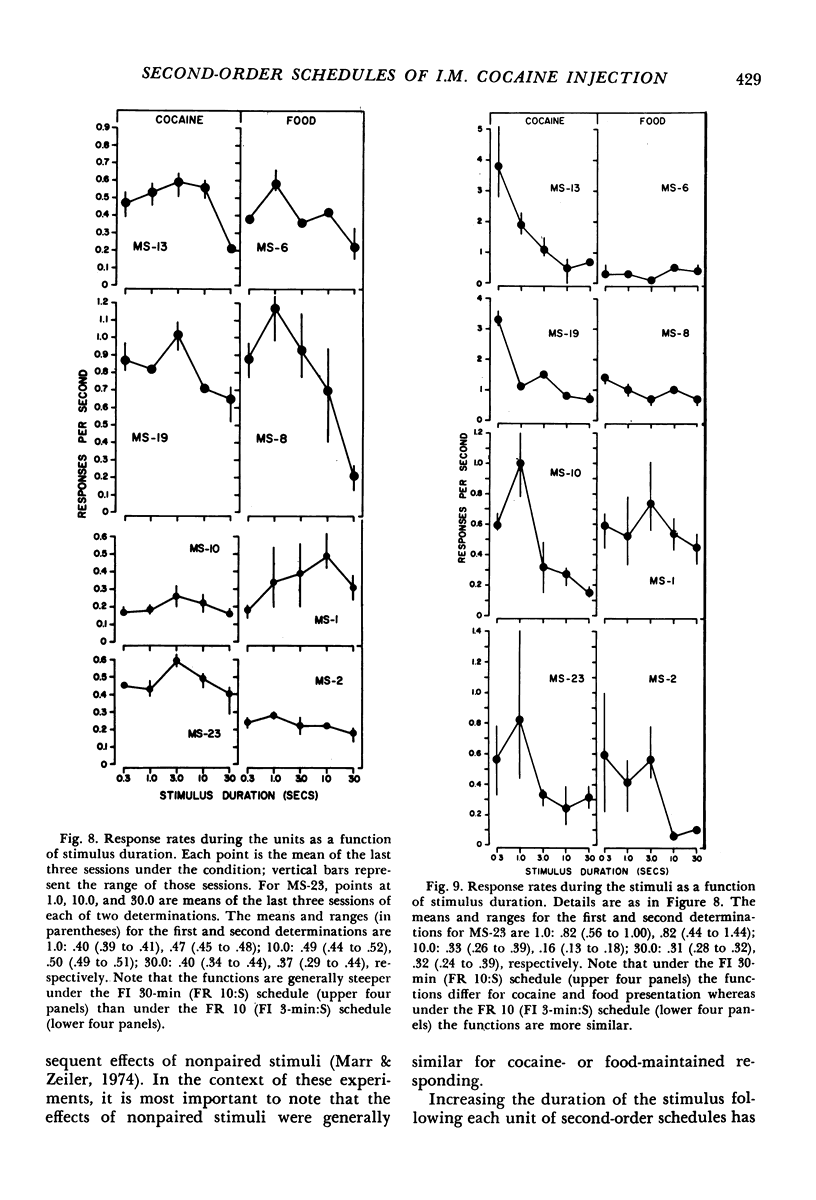
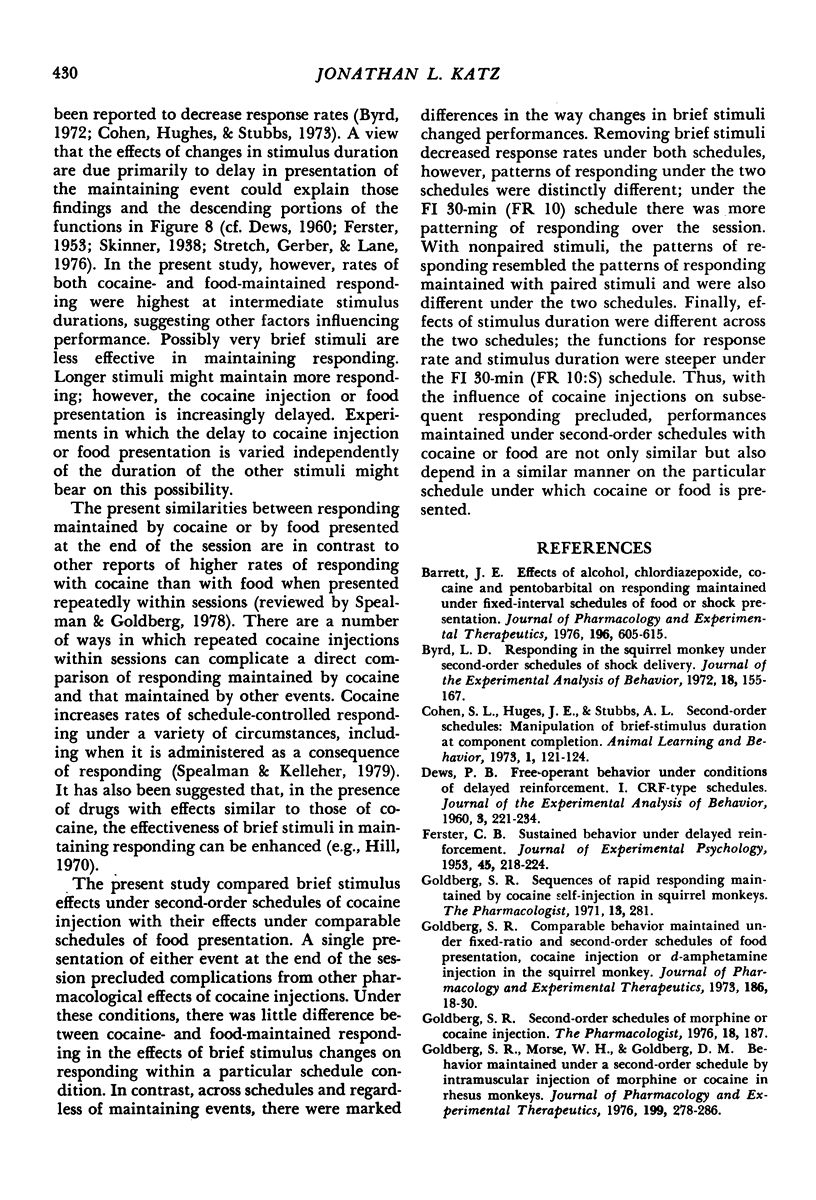

Selected References
These references are in PubMed. This may not be the complete list of references from this article.
- Barrett J. E. Effects of alcohol, chlordiazepoxide, cocaine and pentobarbital on responding maintained under fixed-interval schedules of food or shock presentation. J Pharmacol Exp Ther. 1976 Mar;196(3):605–615. [PubMed] [Google Scholar]
- Byrd L. D. Responding in the squirrel monkey under second-order schedules of shock delivery. J Exp Anal Behav. 1972 Jul;18(1):155–167. doi: 10.1901/jeab.1972.18-155. [DOI] [PMC free article] [PubMed] [Google Scholar]
- DEWS P. B. Free-operant behavior under conditions of delayed reinforcement. I. CRF-type schedules. J Exp Anal Behav. 1960 Jul;3:221–234. doi: 10.1901/jeab.1960.3-221. [DOI] [PMC free article] [PubMed] [Google Scholar]
- FERSTER C. B. Sustained behavior under delayed reinforcement. J Exp Psychol. 1953 Apr;45(4):218–224. doi: 10.1037/h0062158. [DOI] [PubMed] [Google Scholar]
- Goldberg S. R. Comparable behavior maintained under fixed-ratio and second-order schedules of food presentation, cocaine injection or d-amphetamine injection in the squirrel monkey. J Pharmacol Exp Ther. 1973 Jul;186(1):18–30. [PubMed] [Google Scholar]
- Goldberg S. R., Morse W. H., Goldberg D. M. Behavior maintained under a second-order schedule by intramuscular injection of morphine or cocaine in rhesus monkeys. J Pharmacol Exp Ther. 1976 Oct;199(1):278–286. [PubMed] [Google Scholar]
- Goldberg S. R., Tang A. H. Behavior maintained under second-order schedules of intravenous morphine injection in squirrel and rhesus monkeys. Psychopharmacology (Berl) 1977 Mar 16;51(3):235–242. doi: 10.1007/BF00431630. [DOI] [PubMed] [Google Scholar]
- Gonzalez F. A., Goldberg S. R. Effects of cocaine and d-amphetamine on behavior maintained under various schedules of food presentation in squirrel monkeys. J Pharmacol Exp Ther. 1977 Apr;201(1):33–43. [PubMed] [Google Scholar]
- HAKE D. F., AZRIN N. H. An apparatus for delivering pain shock to monkevs. J Exp Anal Behav. 1963 Apr;6:297–298. doi: 10.1901/jeab.1963.6-297. [DOI] [PMC free article] [PubMed] [Google Scholar]
- KELLEHER R. T., GILL C. A., RIDDLE W. C., COOK L. On the use of the squirrel monkey in behavioral and pharmacological experiments. J Exp Anal Behav. 1963 Apr;6:249–252. doi: 10.1901/jeab.1963.6-249. [DOI] [PMC free article] [PubMed] [Google Scholar]
- Kelleher R. T. Characteristics of behavior controlled by scheduled injections of drugs. Pharmacol Rev. 1975 Sep;27(3):307–323. [PubMed] [Google Scholar]
- Kelleher R. T., Goldberg S. R. Fixed-interval responding under second-order schedules of food presentation or cocaine injection. J Exp Anal Behav. 1977 Nov;28(3):221–231. doi: 10.1901/jeab.1977.28-221. [DOI] [PMC free article] [PubMed] [Google Scholar]
- Marr M. J., Zeiler M. D. Schedules of response-independent conditioned reinforcement. J Exp Anal Behav. 1974 May;21(3):433–444. doi: 10.1901/jeab.1974.21-433. [DOI] [PMC free article] [PubMed] [Google Scholar]
- Robbins T. W. The acquisition of responding with conditioned reinforcement: effects of pipradrol, methylphenidate, d-amphetamine, and nomifensine. Psychopharmacology (Berl) 1978 Jun 15;58(1):79–87. doi: 10.1007/BF00426794. [DOI] [PubMed] [Google Scholar]
- Spealman R. D., Goldberg S. R. Drug self-administration by laboratory animals: control by schedules of reinforcement. Annu Rev Pharmacol Toxicol. 1978;18:313–339. doi: 10.1146/annurev.pa.18.040178.001525. [DOI] [PubMed] [Google Scholar]
- Spealman R. D., Goldberg S. R., Kelleher R. T., Goldberg D. M., Charlton J. P. Some effects of cocaine and two cocaine analogs on schedule-controlled behavior of squirrel monkeys. J Pharmacol Exp Ther. 1977 Sep;202(3):500–509. [PubMed] [Google Scholar]
- Spealman R. D., Kelleher R. T. Behavioral effects of self-administered cocaine: responding maintained alternately by cocaine and electric shock in squirrel monkeys. J Pharmacol Exp Ther. 1979 Aug;210(2):206–214. [PubMed] [Google Scholar]
- Stretch R., Gerber G. J., Lane E. Cocaine self-injection behaviour under schedules of delayed reinforcement in monkeys. Can J Physiol Pharmacol. 1976 Aug;54(4):632–638. doi: 10.1139/y76-089. [DOI] [PubMed] [Google Scholar]
- Stubbs D. A. Second-order schedules and the problem of conditioned reinforcement. J Exp Anal Behav. 1971 Nov;16(3):289–313. doi: 10.1901/jeab.1971.16-289. [DOI] [PMC free article] [PubMed] [Google Scholar]


